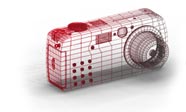 |
|
||
|
|
|
Main / Articles: Nikon keeps focus on camera qualityDigital single-lens reflex cameras keep dropping in price while offering improved features, higher resolution and more functionality each year, and the new Nikon D50 is no exception. About the same price as Canon's EOS Digital Rebel XT, the Nikon D50 offers 6.1 megapixels of resolution in an entry-level digital SLR package that can use a huge array of interchangeable lenses. This price point represents a fundamental shift in the digital camera landscape. You can now purchase an excellent, full-featured digital SLR for under $1,000, including lens. The D50 I tested was supplied with the AF-S DX Zoom-Nikkor 55-200mm f4-5.6G ED lens, which sells for $250. The D50 body without a lens sells for $750, but you'll get better value by buying it as a $900 kit with the AF-S DX Zoom-Nikkor 18-55mm f3.5-56G ED lens. The D50 is a robustly built, compact body with a solid feel and easy-to-use controls. It has a bright, 2-inch LCD screen for reviewing images, built around a 6.1-megapixel imaging sensor. The camera features excellent image quality and remarkably low noise, even at the highest ISO setting of 1600, and can shoot long bursts at 2.5 frames per second when following action sequences. The D50 offers a remarkable set of features for such a low price. The lens I used, the 55-200mm f4-5.6G, has a 35mm focal length equivalent of 82 to 300 millimeters. It was unremarkable. The housing and mount are constructed entirely of plastic; it feels cheap and is not up to the excellent construction standards that Nikon lenses usually have. Then again, it is only $250. The more useful 18-55mm lens (27 to 82mm focal-length equivalent) appears to be similarly constructed. But by purchasing it with the kit, you're only paying $150 for it. In my tests, the lens' sharpness was average at best. When shot wide open, the lens produced significant vignetting, producing dark corners in the image. That was disappointing, given the outstanding capabilities of the camera. If you're looking for imaging results beyond snapshots, and to use the full potential of the excellent image quality the imaging sensor is capable of, spend a bit more for one of Nikon's better lenses. They have plenty. To make sure, I borrowed a friend's 17-35mm f2.8 lens, a $1,500 professional-quality lens, to use with the D50. It rendered beautiful, sharp images. Pros: An excellent, feature-loaded camera capable of producing professional, quality digital photos. Cons: You'll have to get another lens to bring out the camera's full potential, although the 18-55mm lens is a good value as part of the kit. Bottom line: The Nikon is an excellent camera with a similar kit package to the Canon EOS Digital Rebel XT. What you buy comes down to personal preference. Article source: menafn.com by Andrew P. Scott |
| © Copyright 2026 ShutterMag.com All Rights Reserved. |
